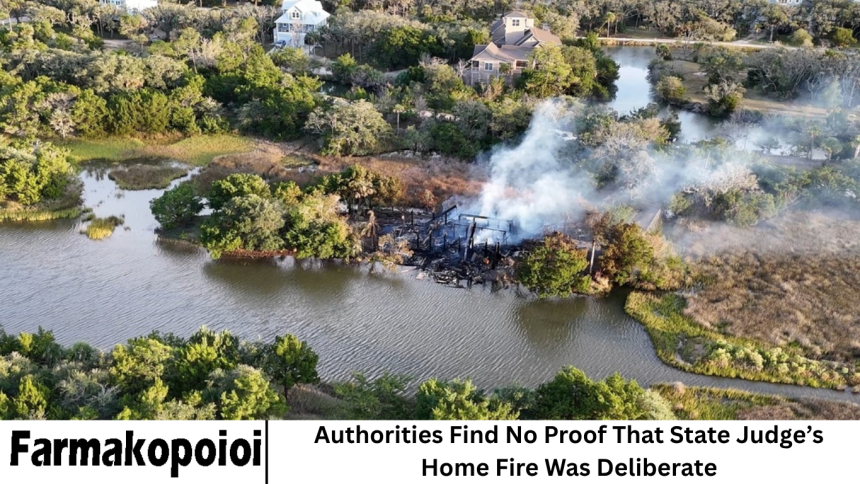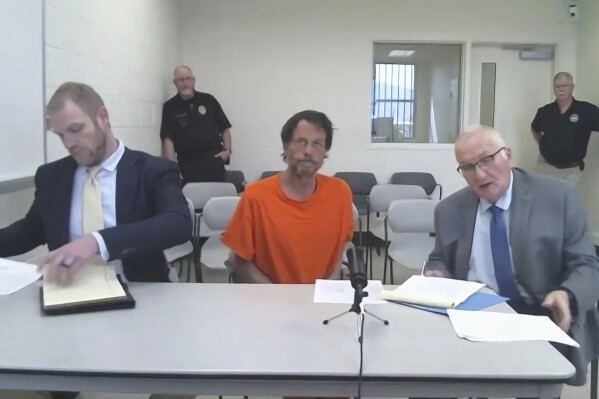A house fire that engulfed the residence of a state judge earlier this month has drawn public and media attention. What initially appeared to be a possible case of targeted arson has now been ruled out by investigators. According to the official report, authorities have found no evidence suggesting that the fire was deliberately set.
- The Incident: How It Unfolded
- Initial Speculations and Public Reactions
- The Investigation: What Authorities Found
- Statement from the Fire Marshal’s Office
- Community and Judicial Response
- Addressing the Dangers of Misinformation
- Fire Safety and Prevention: Lessons from the Incident
- Media Coverage and Public Perception
- Broader Implications: Protecting Judicial Independence and Safety
- Psychological Impact on the Family
- Public Trust in Institutions
- Looking Ahead
- Frequently Asked Question
- Conclusion
The announcement comes after days of speculation and online rumors, fueled by the judge’s high-profile role in several controversial court cases. While law enforcement officials have not disclosed the judge’s name for privacy and safety reasons.
They confirmed that the investigation found no indicators of foul play. The cause of the fire is now believed to be accidental, stemming from an electrical malfunction or household source rather than an act of retaliation or intimidation.
More Read: US Supreme Court Upholds Order Requiring Google to Reform Its App Store Practices
The Incident: How It Unfolded
The fire broke out late on a quiet Sunday evening in a suburban neighborhood. Local emergency services received a call around 9:45 p.m., reporting smoke and visible flames emerging from the back of the property. By the time firefighters arrived, a portion of the house was already engulfed in flames.
The judge and their family were reportedly at home at the time but managed to evacuate safely. No injuries were reported, though the property sustained significant damage, particularly in the living room and kitchen areas.
Neighbors described seeing flashes of light and smoke moments before the fire spread. Several witnesses also claimed to have heard what sounded like a small explosion, leading to early concerns about the possibility of an intentional act.
However, investigators now say those early observations were consistent with the sounds of electrical surges and household materials igniting, not with an explosive or accelerant.
Initial Speculations and Public Reactions
When news broke that the fire had occurred at the home of a state judge, speculation spread rapidly across social media platforms. Many users theorized that the incident might be connected to the judge’s recent rulings, some of which had drawn both public praise and criticism.
Online discussions ranged from conspiracy theories about political motivations to suggestions of retaliation from criminal defendants or activist groups.
Within 24 hours, hashtags referencing the judge and possible arson trended locally. Officials from the state’s judicial office released a statement urging the public to refrain from spreading misinformation, emphasizing that no conclusions had yet been drawn at that stage.
Now, with the investigation officially ruling out deliberate intent, authorities hope the finding will put rumors to rest and allow the community to focus on supporting the affected family.
The Investigation: What Authorities Found
The state’s fire marshal’s office, in coordination with local law enforcement and forensic specialists, conducted a thorough investigation. This included collecting debris samples, reviewing security footage, and interviewing neighbors and witnesses.
Investigators specifically looked for signs of accelerants, forced entry, or tampering with electrical systems — all indicators of possible arson.
After laboratory testing and on-site analysis, the report concluded there were no traces of gasoline, kerosene, or other flammable chemicals that would suggest intentional ignition. Furthermore, there were no signs of a break-in or external interference with the home’s electrical wiring.
A closer look at the fire’s origin point led authorities to identify a malfunctioning circuit panel as the likely cause. Forensic data revealed that the panel had suffered a short circuit, possibly due to overloaded wiring or aging infrastructure.
The fire spread quickly because of dry wooden framing and stored household items that fueled the flames, creating the illusion of a rapid and possibly intentional blaze.
Statement from the Fire Marshal’s Office
In a press briefing, State Fire Marshal Ellen Rodriguez confirmed that the incident had been classified as “accidental in origin.” She said:
“Our team has examined all available evidence and found no indicators of arson or deliberate intent. The fire appears to have started due to an electrical issue within the home’s main circuit panel.
We understand the public’s concern given the homeowner’s position, but there is no evidence linking this event to any criminal act or targeted behavior.”
Rodriguez added that while the investigation is now closed, her office continues to recommend that homeowners conduct regular electrical safety inspections to prevent similar incidents.
Community and Judicial Response
The judicial community has expressed relief that the fire was not an act of violence or intimidation. The state’s Chief Justice issued a statement praising the swift work of emergency responders and investigators, noting:
“While this event has understandably alarmed members of the judiciary, we are reassured by the findings that there was no criminal intent involved. The safety of our judges remains a top priority.”
Neighbors have also come together to support the judge’s family, setting up a local donation drive and temporary housing assistance while repairs are underway. Several community members described the judge as “kind” and “devoted to fairness,” emphasizing that they never believed the fire was intentional.
Addressing the Dangers of Misinformation
This case highlights a broader societal challenge — the rapid spread of unverified claims on social media. In the age of instant online commentary, even local incidents can become breeding grounds for speculation.
Within hours of the fire, hundreds of social media posts circulated, suggesting political or criminal motives without evidence. Some accounts even falsely claimed that the fire was linked to a case involving organized crime.
Law enforcement officials have urged the public to be cautious about drawing conclusions before official reports are released. They emphasized that misinformation not only harms investigations but can also endanger individuals by fueling unnecessary panic or suspicion.
Fire Safety and Prevention: Lessons from the Incident
Although this incident was not deliberate, it serves as a crucial reminder about fire prevention and home safety. Electrical fires are among the most common causes of house fires in the United States, often resulting from outdated wiring, overloaded sockets, or neglected maintenance.
Experts recommend several safety practices:
- Regular Electrical Inspections – Have certified electricians check your wiring every few years.
- Avoid Overloading Circuits – Use surge protectors and distribute appliances across multiple outlets.
- Install Smoke Detectors – Every floor should have functioning detectors, tested monthly.
- Keep Flammable Materials Away from Heat Sources – Simple awareness can prevent major accidents.
- Have an Escape Plan – Ensure all family members know how to exit safely in case of an emergency.
Authorities believe that public awareness and preventive measures could significantly reduce the number of accidental home fires each year.
Media Coverage and Public Perception
Local and national media outlets initially reported on the fire with cautious language, though some headlines implied potential foul play. As the investigation progressed, responsible outlets updated their coverage to reflect verified findings.
Media analysts note that while public curiosity is understandable, sensationalized reporting can create unnecessary anxiety — particularly when public figures are involved.
The shift in tone following the official report reflects the importance of journalistic responsibility in ensuring that narratives align with verified evidence, not speculation.
Broader Implications: Protecting Judicial Independence and Safety
Even though the fire was accidental, the event has reignited discussions about judicial safety and security in the United States. Over recent years, several judges have faced threats, harassment, and even violent attacks related to their rulings.
Judicial associations have long advocated for better home security measures, surveillance, and privacy protections for judges, especially those presiding over controversial cases.
This incident — though not targeted — serves as a reminder that public officials often live under heightened scrutiny and vulnerability. Many are calling for increased funding to strengthen judicial security programs and emergency response systems.
Psychological Impact on the Family
While investigators have cleared the case of criminal intent, the emotional toll on the judge and their family remains significant. Surviving a home fire — even an accidental one — can leave lasting psychological effects, including trauma, anxiety, and a sense of vulnerability.
Community members and local organizations have offered counseling services and emotional support. Friends of the family describe them as resilient but understandably shaken. The judge is reportedly on temporary leave while repairs and recovery efforts continue.
Public Trust in Institutions
In the aftermath of the fire, some commentators have raised questions about public trust in official investigations. In an era of declining faith in institutions, even factual reports can face skepticism.
However, transparency played a key role in restoring confidence in this case. By releasing detailed findings, evidence summaries, and expert testimony, authorities have reaffirmed public trust in both the judicial system and law enforcement.
Officials have emphasized that truth and transparency are vital for preventing misinformation and maintaining societal stability — especially when public figures are involved.
Looking Ahead
As reconstruction begins, the judge and their family are expected to return home once repairs are completed. Insurance assessments are ongoing, and community donations have helped cover temporary relocation costs.
Authorities have closed the investigation but continue to emphasize the importance of fire safety education. Meanwhile, public discourse is shifting toward lessons learned — from misinformation control to safety preparedness and the responsible handling of public speculation.
The story, while initially concerning, ultimately reveals an encouraging truth: not every alarming incident hides a sinister motive. Sometimes, the cause is human error, technical malfunction, or pure accident — reminders that reality often contradicts our fears.
Frequently Asked Question
Was the fire at the judge’s home confirmed to be arson?
No. After an extensive investigation, authorities found no evidence of arson or deliberate intent. The fire was determined to be accidental, likely caused by an electrical malfunction.
Did the judge or their family suffer any injuries?
Fortunately, no one was injured. The judge and their family safely evacuated the home before the fire spread beyond control.
What was identified as the cause of the fire?
Investigators traced the fire to a malfunctioning circuit panel, which caused an electrical short circuit that quickly ignited nearby materials.
Why did people believe the fire might have been deliberate?
Because the homeowner is a state judge, some speculated that the fire could have been linked to controversial rulings or retaliation. Social media amplified these theories before any evidence was available.
How did authorities respond to misinformation online?
Law enforcement and judicial offices urged the public to avoid spreading rumors. They later released a detailed report and held a press conference to clarify the facts and end speculation.
What measures are being taken to ensure the judge’s safety now?
Even though the incident was accidental, the judge’s security detail has been reviewed and strengthened. Judicial protection programs are being reassessed to prevent future risks.
What can homeowners learn from this incident?
This case serves as a reminder of the importance of regular electrical maintenance, installing smoke detectors, avoiding overloaded circuits, and having an evacuation plan — all key steps in preventing house fires.
Conclusion
The official conclusion that there is no evidence the state judge’s home fire was intentional brings relief and clarity after weeks of speculation. Authorities’ methodical approach underscores the importance of relying on facts, not assumptions.
This case illustrates how quickly narratives can spiral in the digital age — and how crucial verified information is in maintaining public calm. Beyond that, it offers lessons in home safety, media responsibility, and institutional trust.
The judge’s ordeal, while tragic, ends on a note of resilience and recovery. It also serves as a wake-up call for communities everywhere: ensuring safety begins not with fear, but with awareness, vigilance, and truth.



















